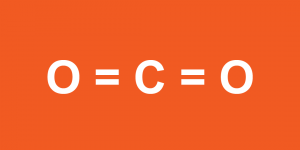Covalent bonds
Atoms with similar electronegativities will not transfer electrons to form an ionic bond between one another. Instead, they may share electrons to form a covalent bond. For example, carbon (C) has an atomic number of 6 and hydrogen (H) has an atomic number of 1. The valence shell of H is the second shell and it is half-full. The valence shell of H is the first shell and it is also half-full. Therefore, these atoms have similar electronegativities. When they come into proximity of one another, the valence electrons of C will complete the valence of H atoms and vice versa. Because these atoms pull on the shared electrons with equal force, the bonds between C and H are nonpolar covalent bonds. The electrons are shared equally between the bonding partners.
In contrast, oxygen (O) has an atomic number of 8 and its valence shell is the second shell. O is much closer to filling its valence shell than H; therefore, O is more electronegative than H. O and H can react to form water (H2O). In water, O and H will share their valence electrons to fill each other’s valence shells. However, because O pulls on electrons with more force, the shared electrons tend to reside with O more often than with either H atom. That means that O carries a partial negative charge (δ-) and C carries a partial positive charge (δ+), resulting in a polar covalent bond between the atoms. Covalent bonds are relatively strong bonds as compared to electrostatic interactions such as ionic or hydrogen bonds.
IMPORTANT: Molecules and compounds are not the same thing!
The atoms in molecules are joined by covalent bonds. Compounds contain two different atoms joined by either covalent or ionic bonds. Molecular oxygen (O2) is a molecule containing two of the same atoms joined by nonpolar covalent bonds. However, O2 is not a compound because it contains only one type of atom. Water (H2O) is both a molecule and a compound because the atoms in water are joined by covalent bonds and it contains two different atoms: O and H.
Chemistry in the clinic:
The polarity of a molecule is determined by the polarity of the covalent bonds within the molecule as well as the way the bonds are arranged. For example, carbon dioxide (CO2) is a nonpolar molecule, despite containing two atoms with very different electronegativities. In CO2, carbon forms two double bonds to each of the two oxygen atoms. Because the electron pairs strongly repel one another, CO2 takes on a linear shape (Figure 8). The two oxygens face away from one another symmetrically, effectively cancelling the polarity of the C-O bonds. For this reason, CO2 is poorly soluble in aqueous solutions such as blood plasma. You will learn in a future lecture on blood that CO2 must be converted into a soluble compound called carbonic acid (H2CO3) by the action of an enzyme called carbonic anhydrase in red blood cells.


